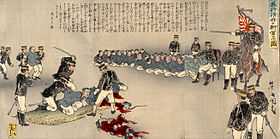Century of humiliation

The century of humiliation (simplified Chinese: 百年国耻; traditional Chinese: 百年國恥; pinyin: bǎinián guóchǐ; Wade–Giles: pai3 nien2 kuo2 chi3), also known by permutations such as the hundred years of national humiliation, refers to the period of intervention and imperialism by Western powers and Japan in China between 1839 and 1949.[1]
The term arose in 1915, in the atmosphere of rising Chinese nationalism opposing the Twenty-One Demands made by the Japanese government and its acceptance by Yuan Shikai, with the Guomindang and Chinese Communist Party both subsequently popularizing the characterization.[2]
History
The beginning of the Century of Humiliation is usually dated to the mid-19th century, on the eve of the First Opium War[3] amidst widespread opium addiction and the political unraveling of Qing dynasty China that followed.[4]
Other major events often cited as part of the Century of Humiliation are the unequal treaties of Whampoa and Aigun, the Taiping Rebellion, the Second Opium War and the sacking of the Old Summer Palace, Eight-Nation Alliance suppressing the Boxer uprising,[5] the Sino-French War, the First Sino-Japanese War, the British invasion of Tibet,[6] the Twenty-One Demands by Japan, and the Second Sino-Japanese War. In this period, China lost all the wars it fought, often forced to give major concessions to the great powers in the subsequent treaties.[7]
The time for an end of the Century has been open to different interpretations. Both Chiang Kai-shek and Mao Zedong declared the end of the Century of Humiliation in the aftermath of World War II, with Chiang promoting his wartime resistance to Japanese rule and China's place among the victorious Allies in 1945, while Mao declared it with the establishment of the People's Republic of China in 1949. The idea of an end of the Century was similarly declared in the repulsion of UN forces in the Korean War, the 1997 reunification with Hong Kong, the 1999 reunification with Macau, and even the hosting of the 2008 Summer Olympics in Beijing.[2] Some still say that the Century will not end until Taiwan is reunified with the mainland.[2][8]
Implications
The usage of the Century of Humiliation in the Chinese Communist Party's historiography and modern Chinese nationalism, with its focus on the "sovereignty and integrity of [Chinese] territory",[9] has been invoked in incidents like the US bombing of the Chinese Belgrade embassy, the Hainan Island incident, and protests for Tibetan independence along the 2008 Beijing Olympics torch relay.[10] Some analysts have pointed to its use in deflecting foreign criticism of human rights abuses in China and domestic attention from issues of corruption, while bolstering its territorial claims and general economic and political rise.[2][11][12]
Criticism
Jane E. Elliott criticized the allegation that China refused to modernize or was unable to defeat Western armies as simplistic, noting that China embarked on a massive military modernization in the late 1800s after several defeats, buying weapons from Western countries and manufacturing their own at arsenals, such as the Hanyang Arsenal during the Boxer Rebellion. In addition, Elliott questioned the claim that Chinese society was traumatized by the Western victories, as many Chinese peasants (90% of the population at that time) living outside the concessions continued about their daily lives, uninterrupted and without any feeling of "humiliation".[13]
See also
References
- ↑ Alison Adcock Kaufman, "The “Century of Humiliation,” Then and Now: Chinese Perceptions of the International Order," Pacific Focus 25.1 (2010): 1-33.
- ↑ 2.0 2.1 2.2 2.3 Kilpatrick, Ryan (20 October 2011). "National Humiliation in China". e-International Relations. Retrieved 3 April 2013.
- ↑ Paul A Cohen (2003). China Unbound. London: Routledge. p. 148.
- ↑ Chang, Maria Hsia (2001). Return of the dragon: China's wounded nationalism. Westview Press. pp. 69–70. ISBN 978-0-8133-3856-9.
- ↑ Hayes, Peter (2004). China's New Nationalism: Pride, Politics, and Diplomacy. University of California Press. pp. 43–49. ISBN 9780520931947.
- ↑ "China Seizes on a Dark Chapter for Tibet", by Edward Wong, The New York Times, August 9, 2010 (August 10, 2010 p. A6 of NY ed.). Retrieved 2010-08-10.
- ↑ Nike, Lan (2003-11-20). "Poisoned path to openness". Shanghai Star. Retrieved 2010-08-14.
- ↑ Muthiah Alagappa (2001). Taiwan's Presidential Politics. New York City: M. E. Sharpe. p. 33.
- ↑ W A Callahan. "National Insecurities: Humiliation, Salvation and Chinese Nationalism" (PDF). Alternatives 20 (2004): 199.
- ↑ Jayshree Bajoria (April 23, 2008). "Nationalism in China". Council on Foreign Relations.
- ↑ "Narratives Of Humiliation: Chinese And Japanese Strategic Culture – Analysis". Eurasia Review. International Relations and Security Network. 23 April 2012. Retrieved 3 April 2013.
- ↑ Callahan, William (15 August 2008). "China: The Pessoptimist Nation". The China Beat. Retrieved 3 April 2013.
- ↑ Jane E. Elliott (2002). Some did it for civilisation, some did it for their country: a revised view of the boxer war. Chinese University Press. p. 143. ISBN 962-996-066-4. Retrieved 2010-06-28.